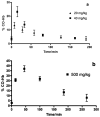Characterization of a versatile organometallic pro-drug (CORM) for experimental CO based therapeutics
- PMID: 23223860
- PMCID: PMC3618497
- DOI: 10.1039/c2dt32174b
Characterization of a versatile organometallic pro-drug (CORM) for experimental CO based therapeutics
Abstract
The complex fac-[Mo(CO)(3)(histidinate)]Na has been reported to be an effective CO-Releasing Molecule in vivo, eliciting therapeutic effects in several animal models of disease. The CO releasing profile of this complex in different settings both in vitro and in vivo reveals that the compound can readily liberate all of its three CO equivalents under biological conditions. The compound has low toxicity and cytotoxicity and is not hemolytic. CO release is accompanied by a decrease in arterial blood pressure following administration in vivo. We studied its behavior in solution and upon the interaction with proteins. Reactive oxygen species (ROS) generation upon exposure to air and polyoxomolybdate formation in soaks with lysozyme crystals were observed as processes ensuing from the decomposition of the complex and the release of CO.
Conflict of interest statement
Notes
J. D. Seixas, L. E Otterbein, D. J. Gallo, S. S. Rodrigues, B. H. Guerreiro, A. M. L. Gonçalves, N. Penacho, A. R. Marques, P.M. Reis and C. C. Romão worked for and hold financial interests in Alfama Inc.
Figures







Similar articles
-
Study of the interactions of bovine serum albumin with a molybdenum(II) carbonyl complex by spectroscopic and molecular simulation methods.PLoS One. 2018 Sep 27;13(9):e0204624. doi: 10.1371/journal.pone.0204624. eCollection 2018. PLoS One. 2018. PMID: 30261022 Free PMC article.
-
CORM-3 reactivity toward proteins: the crystal structure of a Ru(II) dicarbonyl-lysozyme complex.J Am Chem Soc. 2011 Feb 9;133(5):1192-5. doi: 10.1021/ja108820s. Epub 2011 Jan 4. J Am Chem Soc. 2011. PMID: 21204537
-
Examining the antimicrobial activity and toxicity to animal cells of different types of CO-releasing molecules.Dalton Trans. 2016 Jan 28;45(4):1455-66. doi: 10.1039/c5dt02238j. Dalton Trans. 2016. PMID: 26673556
-
Developing drug molecules for therapy with carbon monoxide.Chem Soc Rev. 2012 May 7;41(9):3571-83. doi: 10.1039/c2cs15317c. Epub 2012 Feb 20. Chem Soc Rev. 2012. PMID: 22349541 Review.
-
Metal-based carbon monoxide releasing molecules with promising cytotoxic properties.Dalton Trans. 2024 Jun 10;53(23):9612-9656. doi: 10.1039/d4dt00087k. Dalton Trans. 2024. PMID: 38808485 Review.
Cited by
-
Carbon Monoxide as a Therapeutic for Airway Diseases: Contrast and Comparison of Various CO Delivery Modalities.Curr Top Med Chem. 2021;21(32):2890-2908. doi: 10.2174/1568026621666211116090917. Curr Top Med Chem. 2021. PMID: 34784868 Free PMC article. Review.
-
Fluorescent small molecule donors.Chem Soc Rev. 2024 Jun 17;53(12):6345-6398. doi: 10.1039/d3cs00124e. Chem Soc Rev. 2024. PMID: 38742651 Free PMC article. Review.
-
Neuroprotection and neuroregeneration of retinal ganglion cells after intravitreal carbon monoxide release.PLoS One. 2017 Nov 27;12(11):e0188444. doi: 10.1371/journal.pone.0188444. eCollection 2017. PLoS One. 2017. PMID: 29176876 Free PMC article.
-
Carboxyhemoglobin (COHb): Unavoidable Bystander or Protective Player?Antioxidants (Basel). 2023 May 31;12(6):1198. doi: 10.3390/antiox12061198. Antioxidants (Basel). 2023. PMID: 37371928 Free PMC article. Review.
-
Carbon monoxide--physiology, detection and controlled release.Chem Commun (Camb). 2014 Apr 11;50(28):3644-60. doi: 10.1039/c3cc49196j. Chem Commun (Camb). 2014. PMID: 24556640 Free PMC article. Review.
References
-
- Mann BE. In: Top Organomet Chem. Jaouen G, Metzler-Nolte N, editors. Springer; Berlin: 2010. pp. 247–285.
-
- Motterlini R, Otterbein LE. Nat Rev Drug Discov. 2010;9:728–743. - PubMed
-
- Romão CC, Blättler WA, Seixas JD, Bernardes GJL. Chem Soc Rev. 2012;41:3571–3583. - PubMed
-
- Motterlini R, Clark J, Foresti R, Sarathchandra P, Mann B, Green C. Circ Res. 2002;90:E17–E24. - PubMed
-
- Clark J, Naughton P, Shurey S, Green C, Johnson T, Mann B, Foresti R, Motterlini R. Circ Res. 2003;93:E2–E8. - PubMed
Publication types
MeSH terms
Substances
Grants and funding
LinkOut - more resources
Full Text Sources
Other Literature Sources

